Menu
Menu
close
Why I don't "believe" in ALLERGIES!
Meet sweet "Molly". Molly was diagnosed with allergies, not only by her regular veterinarian, but also by a board certified veterinary dermatologist. Molly was prescribed steroids, antibiotics, special prescription diets, and discussions of allergy shots and life long administrations of drugs like Apoquel or immune modulating drugs like Cyclosporine were pushed heavily as the "answer" for Molly's severe discomfort.
For months, Molly had been itching horribly. Her face and chin itched so badly, she would rub them all over the carpet of the house, resulting in blood streaks and stains that her caretakers (who also had their house on the market for sale) would have to clean up repeatedly. Molly would appear to improve slightly on some treatments (steroids make everything "seem" better) - then when the medications were finished, she would be back to itching with a vengeance.
When I met Molly's mom - it was clear to me that something was missing in Molly's treatment plan. One of my biggest pet peeves is when secondary infections are either not treated, or treated with inadequate protocols. Not only had Molly not received a long enough duration of antibiotics for deep skin infections, she was also never treated for the potential secondary yeast infections that seemed very likely to be present. Her dermatologist took a "sample" from the feet, did not see yeast, and ruled it out as a potential cause of her issues.
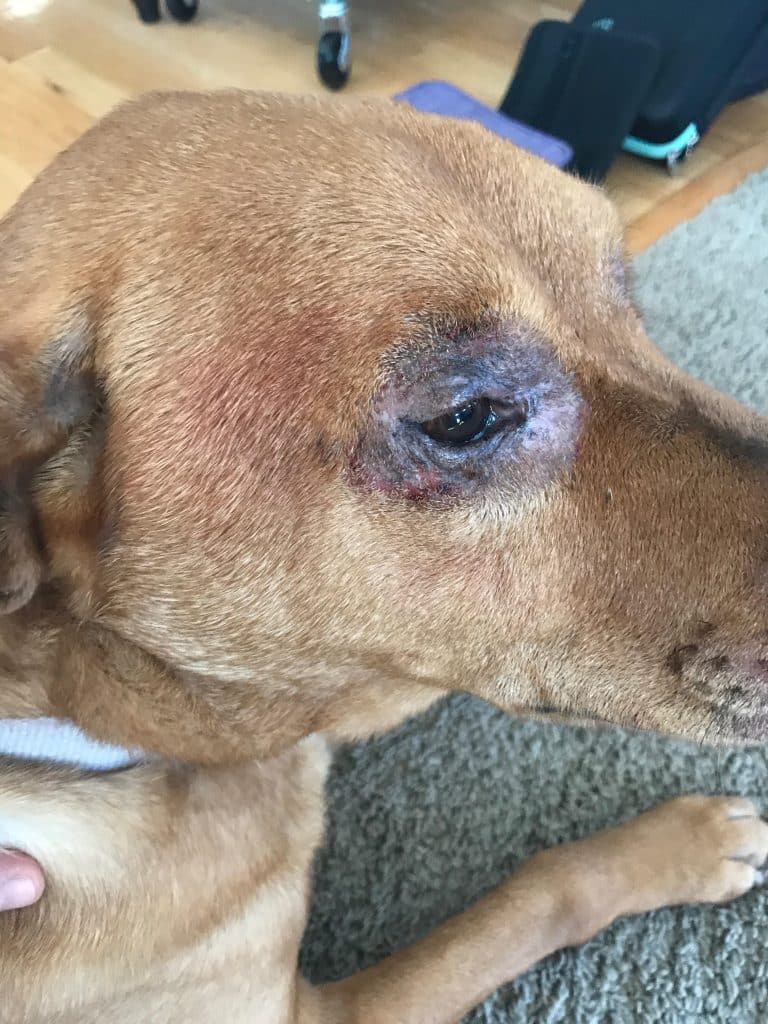
You may have heard my soap box before - but here it is again. The sensitivity of "yeast testing" for the skin is poor at best. If you get a negative test for yeast on any type of skin test - to me it means absolutely nothing. Certainly if we see a lot of yeast, it is likely to be an issue for the animal. But the fact that a veterinarian may not find yeast at all - in a culture, a scraping, or a tape prep... MEANS NOTHING in my eyes. I had recommended to Molly's mom that she request a treatment trial of Ketonconazole for potential yeast infections, while also repeating a round of Cephalexin for possible staph bacterial infections. In my practice, when I treat with these two drugs, I eliminate any need for steroid use at all. Treating the primary cause of the itching is the utmost importance.
Many vets shy away from a treatment round of Ketoconazole. I personally find they are more afraid of a drug that has less complications associated with it (when prescribed properly) than the steroids or other medications that they are recommending. Steroids have KNOWN complications and side effects. It is pretty much accepted that they will increase liver enzymes with long term use. But when an owner mentions the possible use of Ketoconazole to their veterinarian - they get a lot of backlash. "Oh that would be hard on their liver." In my opinion, a vet shouldn't be any more worried to use Ketoconazole than steroids! I actually loathe steroids more than Ketoconazole any day of the week! I can assure you your dog will experience side effects with steroids. Increased drinking, increased urination, and other potential serious issues are common place with steroids, and veterinarians just warn you in advance of the "side effects" that you are destined to see. But…mention the use of Ketoconazole and they are fearful.
I would like to clear up why Ketoconazole is so often feared. Mainly I find it is due to lack of understanding, which also is compounded by improper dosage use. Ketoconazole is recommended within our Veterinary Drug Handbooks in quite a wide range of doses. You can find recommendations for skin yeast infections (Malassezia) that range from 5 to 10 milligrams per kilogram of body weight. (5-10 mg/kg). And you can find recommendations for it to be given once a day or twice a day. While there are potential adverse effects associated with Ketoconazole, many of these are dose related. With proper clinical use of the drug - I recommend 5mg/kg twice a day - we seem to not see these reported adverse effects, of which GI upset is most common. When you think about it - the use of 10mg/kg, which is still within many of the recommended dosing protocols, is DOUBLE the dose that I use in my practice. And when a drug has an option of being given once or twice a day, it usually indicates that the therapeutic window of the drug will actually run out within 12 hours or so. While some veterinarians may see therapeutic effects with once a day dosing and certainly owners may desire to only medicate once a day - what is best for the dog is a lower dose twice a day to a be most effective while avoiding any stomach upset or other adverse effects. Almost every case I have investigated of a dog not tolerating Ketoconazole, has usually been from the higher range of dosing being prescribed, and often it is being used only once a day. Ketoconazole generally comes in a 200mg tablet, so I often prescribe 1/2 pills and even 3/4 pills to obtain a dose as close as possible to 5mg/kg.
While we are talking about dosing - let's also discuss length of treatment. For my practice, a dog for which I suspect secondary infections, will go onto a 21 day course of both Ketoconazole and Cephalexin. Owners are instructed to keep giving the medication until my recheck exam (approximately in 21 days) - and to not run out of the medications prior to the recheck. I want them to stay on the drugs until I can say to stop. In my vet school, I was taught by some amazing dermatologists. And for deep, chronic infections (likely dogs diagnosed with allergies have been suffering with infections for many months to years), the treatment should be continued for approximately 2 weeks beyond resolution of all signs or symptoms. For some of my patients, this will mean they will be on medications for months. But the main point is, never pause or stop the treatment. Treatment must be continued for an additional 2 weeks after all signs of infection are gone. Many times I find I can stop the Cephalexin portion of the treatment earlier than the yeast, but even this may be after 2 rounds or more of the 21 day cycles.
Now for a word on Cephalexin. This is an antibiotic - so will not be effective against yeast. Ketoconazole is an anti-fungal medication - so this is the type of medication needed when yeast needs to be killed. So many allergy dogs have received round after round of various antibiotics, but rarely are they ever treated for yeast systemically. Sure, topical anti-fungal lotions, creams, and shampoos are often used. But to really get to the root of the problem, I typically find an orally administered anti-fungal is needed. Cephalexin is generally used for Staphylococcus bacterial infections of the skin. This is the more common cause of infections, and it may look like little red dots, little pimples, flaky round lesions, or a variety of odd skin appearances. Cephalexin is generally dosed at 10 milligrams per pound of body weight, and it is given two to three times a day. For most cases, I can use twice a day dosing. For severe infections or those that do not respond completely, we may try dosing three times a day (as close to every 8 hours as possible). The important dosing note with Cephalexin is to error on giving a bit too much, than too little. If your dog weighs 77 pounds, I would not be giving only 750mg of the drug twice a day. I would increase to the next dosage available (Cephalexin generally comes in 500mg and 250mg capsules) - so a dog over 75 pounds will get 1000mg of Cephalexin twice a day. Again this will generally be dosed for 21 days, making sure the drug is continued until the recheck exam can evaluate if it is needed still or it can be discontinued.
Cephalexin can make some dogs nauseous. This seems especially common in Pit Bull dogs (of which I have had a house full!), but any breed can experience nausea from Cephalexin. This could mean just not wanting to eat or even a bit of vomiting or drooling. We will often try Cephalexin first, as it is a more affordable alternative to "Simplecef" (Cefpodoxime Proxetil). Simplecef is given once a day and at the recommended dosages is quite effective. Most dogs who do not tolerate Cephalexin tolerate Simplecef just fine. The same duration of treatment is used with either Cephalexin or Simplecef. Treat for at least 21 days and never stop giving the treatment until 2 weeks after recheck examinations confirms all signs and symptoms are resolved.
Okay, now that you have had almost a years worth of vet school condensed into a few paragraphs...what if your veterinarian will absolutely not work with you on a trial treatment (as Molly's dermatologist would not), or you wish to stay absolutely natural in your treatments? Let me give you a couple of my thoughts here. For many people, their dog has already been on steroids, many rounds of antibiotics, Apoquel, Cyclosporin (Atopica), and a variety of other medications like Benadryl, Temaril-P, other anti-histamines, allergy shots, Cytopoint shots, elimination diets, and the list can go on forever! For these cases, I do not feel that using traditional medications PROPERLY is any more of an issue than what has already been done. Traditional medications SHOULD be embraced when cases are severe, or there has already been a lot of use of traditional drugs in my opinion. We should never be a martyr when it comes to demanding the use of "all natural" remedies if your dog is miserable. There is a reason that traditional medication is available to us. And sometimes there are clear indications that we should utilize it - especially when that means FINALLY eliminating the problem instead of just continuing to cover it up. Indeed, you may need to look for another veterinarian if yours is closed to trying a treatment trial.
If your dog is just mildly affected (Molly would be classified as severe), there are some natural remedies we can use without the use of traditional medications - and essential oils are a large part of my treatment protocols. Topical applications of animalEO Essential Oil blends such as AromaBoost (RTU or LITE) at least once a week, Boost in a Bottle (original or LITE) in between those applications, diffusion of animalEO blends such as Open-Air, Exhale, or Strength (and many others) within the home can help reduce symptoms and contribute greater comfort and healing.
Then we have symptom specific blends such as YeastyBeasty RTU and YeastyBeasty NEAT. You can read about all of these products on their individual product pages for tips and instructions on how to use them. I love to make a wonderful shampoo with YeastyBeasty NEAT and 4-Legger Organic Shampoo - which can replace many toxic prescription "anti-fungal" shampoos. Read about making essential oil shampoo on our Shampoo Page.
Skin Spray Base can also be added to shampoo as well as used within a water-mist to soothe and comfort skin. It can reduce infections, itching, redness, and promote the body to heal while supporting normal immune function. For severe cases such as Molly, I would still layer treatments with essential oils along with traditional medications. For all animals I still feel essential oils can be vital in providing additional comfort and support to their immune system and healing.
All animalEO blends are safe to use with other medications, or with other health conditions your dog may have - when used as directed. All are safe, and actually expected, to be groomed or licked off of the animal they are applied to. If your dog is repeatedly licking and chewing their feet - then I would be a pretty stupid veterinarian to attempt to apply something to those feet that "shouldn't" be licked off! It would make your life pretty difficult actually! So, in all reality - I intend for these blends to be licked, absorbed, and somewhat ingested. I say "somewhat ingested" because when essential oils are licked or "chewed" off of the skin, they are actually absorbed into the oral mucosa, not swallowed. So ingestion of oils technically means that they are swallowed. When an essential oil is swallowed, it actually is metabolized more by the body than when it is absorbed through the tongue or oral tissues. So a "licked" essential oil blend is actually more "bio-available" than a blend added to food in theory. However, we can certainly add more essential oils into foods, than we can expect or regulate to be "licked and absorbed" so we can often use both scenarios to our advantage.
These facts actually spurred our customers, who could not get their veterinarians to authorize a trial treatment for secondary infections (especially yeast), to start adding YeastyBeasty RTU to their dogs' food. The thought process was that if it was safe to ingest, then maybe adding a bit extra would be even more helpful from the inside out. And guess what!? It has been. The dosing range has actually been quite wide, but even just a little bit added to each meal (1-2 drops) no matter what the dogs size, has shown results. When we consider that 8-10 drops may be applied topically to each foot or area that is affected on your dog, and then some of this may be licked off…we can really consider that quite a lot of this blend could be ingested or absorbed. I calculate all safety considerations regarding doses with very exacting standards when I formulate blends - so I have no concern at all that adding this blend into your dogs food would cause any negative issues. If you wish to try this out for yourself, I recommend that you start with one drop to each meal, and then monitor that amount being given for at least 3 days. If you see no adverse issues (soft stools or not wanting to eat), and wish to increase the amount given, then you can start adding 2 drops. I usually suggest that you wait at least 3 days after any changes in diet or protocols so that you can fully see what effects the changes have on the body, before making another change. If we change too many things, too quickly - it can become confusing to see which item helps, and which item may be hurting the situation.
So let's go back to Molly, and why I do not believe in allergies. Before Molly became my patient, I saw "Jack". Poor Jack had such severe issues, we were actually seeing him as a final option. His caretakers felt they were out of all options, and that he was so severe with "allergies" that no one could manage, that he would have to be put to sleep. Below is just one of Jack's feet.
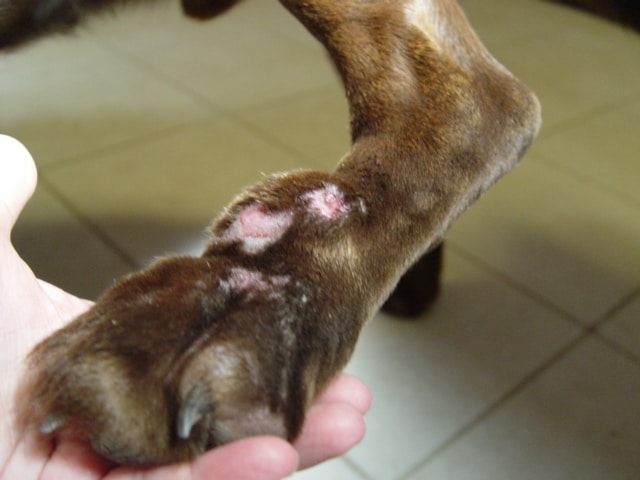
Poor Jack looked like this on all of his feet. They were swollen, red, missing hair, and many lesions had open wounds. Nothing could control Jack's condition and he was miserable. As a veterinarian who does not like to give up on anything, and one who feels strongly "THERE IS ALWAYS AN ANSWER" - I recommended that we treat Jack for secondary DEEP infections. Jack was on both Cephalexin and Ketoconazole (no steroids required) for several months. But every 21 days when he returned for a recheck, he continued to look better and better. Below is a photo of his next recheck exam.
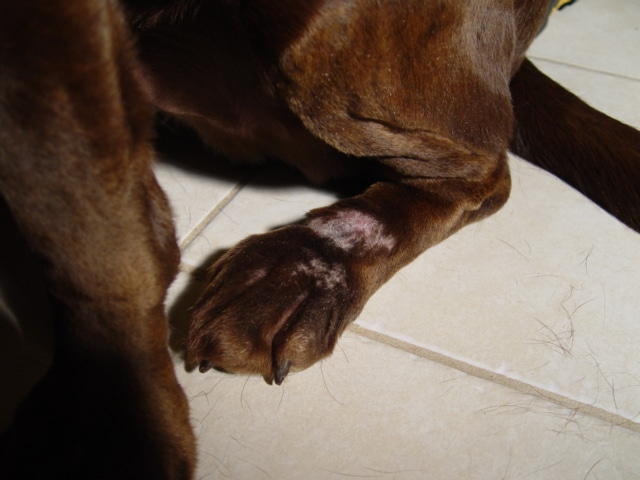
Massive improvement was noted. The swellings had gone, the itching was so much less severe…Jack was on the mend. But I was not about to stop treatment yet. I was taught to treat 2 weeks beyond resolution of ALL signs. So Jack was on another 21 days of Cephalexin and Ketoconazole. A bit over a month later - at the next recheck - this is the same foot pictured below!
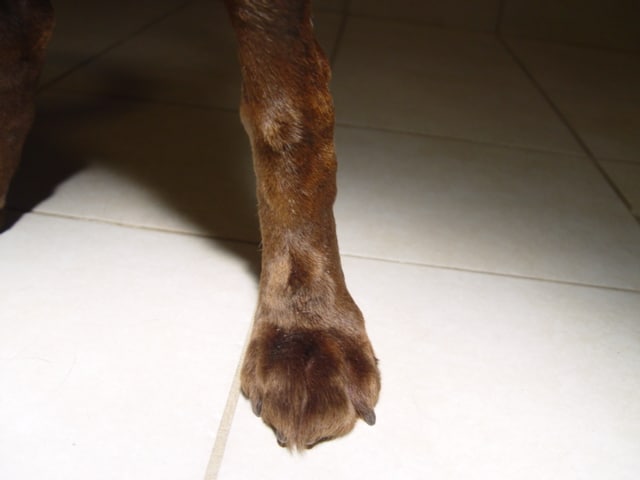
Jack's case taught me a lot. I have always had a stubborn streak, and for Jack, the fact that I never want to give up - meant he could continue living. That is a huge reward to me. It is what this veterinarian desires most - to find a solution to a problem and help an animal have a better quality of life!
With Molly - I decided to take her on as a patient as I knew her mom, and I would be in classes with her for many months actually. So rechecks and updates on Molly's condition were a breeze! Molly was miserable, and while her other veterinarians (dermatologist included) had medicated her and tried lots of things, she only obtained minimal comfort. Since everyone had refused to treat Molly with anti-fungal medications, I definitely wanted to eliminate that from my list of potential concerns. So Molly went on a round of Cephalexin and Ketoconazole. Within a week to two weeks though, Molly was still pretty itchy. This is not the typical response I see when only secondary infections are the cause of the pruritis (itching). I also felt strongly that Molly's "pattern of distribution" was a bit odd to only be involved with secondary yeast and bacterial infections. There are classic locations for many infections in dogs - and for many skin diseases. Molly had a lot of symptoms concentrated to her eyes and chin, which for me, makes me start to wonder about autoimmune diseases or mites more commonly. Although I am certain Molly was still dealing with other secondary infections that would need to be dealt with, I felt certain there was some other underlying cause for her condition.
Because she continued to be "so itchy", and because her owner reported that she felt better on steroids, but once they were gone symptoms returned even worse than before…I really wondered about her potential for sarcoptic mite infection. Turns out, Molly lives with another dog. And, this other dog is a Maltese. What do I know about Maltese? They go to a groomer quite often. Molly also had a history of visiting a dermatologist. What do these two locations have in common? Other dogs visit them, there is a potential for exposure to contagious diseases, AND when dogs have skin issues they often show up to a dermatologist or a groomer. So unfortunately, these locations by default, have more potential for your dog to be exposed to "bad things" if owners are seeking solutions to why their dog is itching in the first place. I know when we would have an "itching" dog come into our vet clinic, and we subsequently diagnosed sarcoptic mange (mites) - we would close down that exam room for disinfection, and ideally not have any dogs come into the clinic until a full cleaning regimen could be instituted.
When I asked more about Molly's Maltese room mate… turns out he had also been more itchy lately. Hmmmm. Now, I was greatly suspecting that both dogs in the household could have Sarcoptic mites. And most likely Molly became more severe due to her secondary infections that compounded the situation. The steroids Molly was prescribed for her "allergies" - suppressed her immune system - and while they may have made her less inflamed and miserable for a short time - they also allowed the mites to flourish and become worse than before the steroids were given. But ask her dermatologist, and he was confident that Molly was an allergy dog, and an allergy dog only.
Like all good stories, you would like to know the ending, right?! For very special people and animals, I do take on some one on one cases still. Molly just tore at my heart strings enough for me to have her stop out at my home on a Sunday, so we could start a trial treatment for her and her "brother" for sarcoptic mange. Sarcoptic mites can be very difficult to find on skin scrapings. So occasionally when we are convinced that the history and symptoms coincide with potential infection, we will also do a treatment trial for the mites. I am a bit old fashioned, so for dogs who can have Ivermectin - I still prefer to give a subcutaneous injection of this drug (herding breeds and collies should not get Ivermectin products). I have performed treatment trials in many itchy dog households throughout my veterinary career - and for those dogs who have responded - it is nothing short of Heaven for their owners. Many of the treatment trials had been scraped over and over again, finding nothing. Treated with steroids over and over again, only to get worse. Usually within 24 hours of ONE shot, the dog will start to feel less itchy (as long as we also control secondary infections!). And that was the case for Molly and her room mate. Within 1-2 days, Molly's mom reported that both dogs were so much more comfortable and there was significantly less itching.
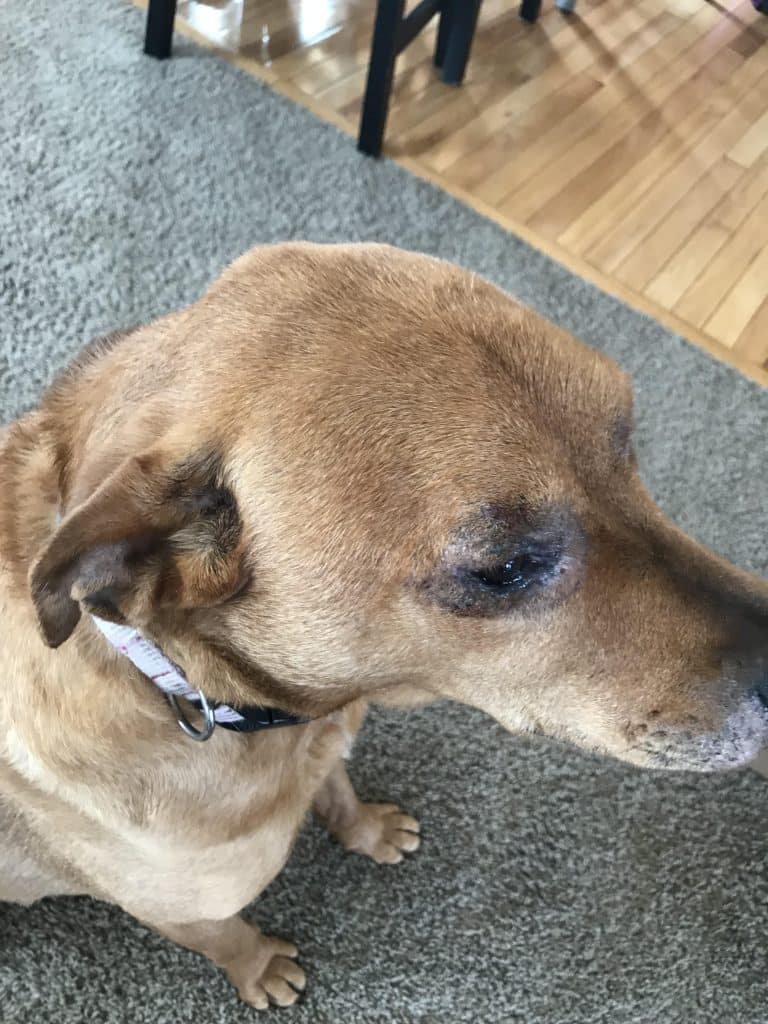
Molly continues to improve (as does her brother). The injection of Ivermectin will be repeated (2 weeks after the first), and for some dogs I will even give a third shot. I continued Molly on her treatments for secondary infections, but likely she will not need these for long once the mites are dead and gone. For sure we can see improvements for even mis-diagnosed "allergy" dogs with the use of essential oils, as most essential oils have broad spectrum effects. Even if I had Molly using an essential oil shampoo recipe for what we considered to be secondary yeast infections, those essential oils will often carry some insect killing capacity. Oils can be antibacterial, anti-fungal, anti-inflammatory, and insect repelling or killing. Everything that a "skin case" may need, even if we don't recognize the primary cause. And essential oils can do so much more too! Relief of itching, support of the immune system, calming emotional stress, supporting drug metabolism and health of a liver that has been insulted by prescription medications… Every single case can benefit from essential oils!
Before I leave you completely, I feel I should address what you may feel are "true" allergies. I know some of you are saying, "But, my dog TRULY is allergic to beef" (or pollen, or dust mites, etc…). While there are items that aggravate dogs and can be categorized as "allergies" - and it can still be entirely helpful to avoid these items - I have witnessed more cases of "complicated" allergies than I can count. So, to explain it fully - your dog IS allergic to a certain pollen. This pollen aggravates your dog's skin, and creates a very unhappy environment. Some scratching may occur. Additional skin oils are secreted from irritated skin which provide a happy home for yeast and bacteria. Skin that has lost its ability to maintain perfect defense mechanisms… allows secondary infections to take hold. Now, while it may be true that Spring time has brought the pollen that decreases the skins optimal health - it is the secondary infections that often contribute to the largest percentage of the symptoms you see. Scratching, chewing, blackened and thick skin - these are often not from the allergies as much as from the secondary yeast and bacteria that have invaded the skin. If you have ever had a yeast infection as a woman - you can sympathize with what it must be like for these dogs to have yeast infections of the paws, chin, armpits, groin, etc… Unfortunately, yeast remains the least effectively treated secondary infection that tends to be present when a dog is diagnosed with "allergies". When secondary yeast infections are treated, even dogs with "true allergies" can often remain comfortable enough to not warrant the use of potentially harmful prescription medications.
Disclaimer: This information was provided for educational purposes only, and has not been evaluated by the FDA. It is not intended to diagnose, prescribe for, or treat any illness. If you or your animal have a health concern, you are encouraged to seek the counsel of a health care professional who is knowledgeable in your area of interest.

Be the first to hear about Sales, Limited Edition Oils, & Special Opportunities!

